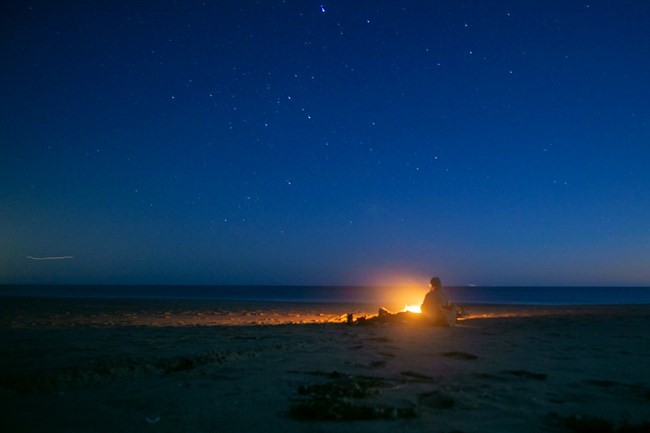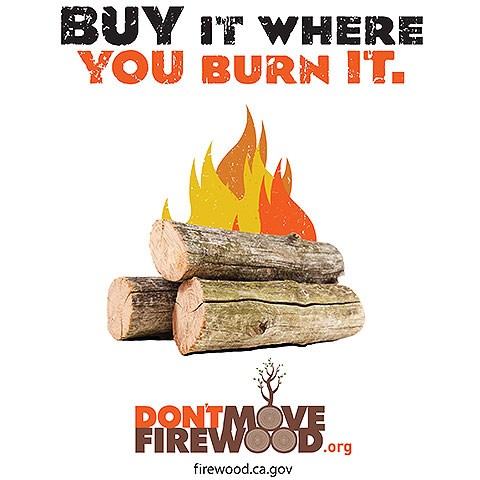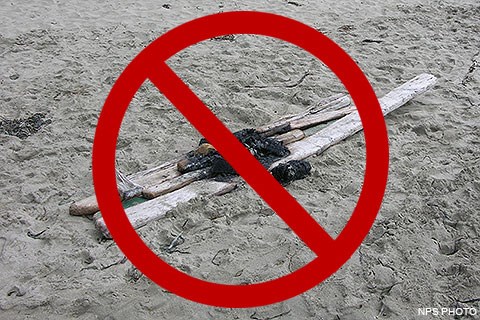
NPS Photo / Anela Kopshever Beach Fire Rules and RegulationsBeach Fire PermitsFires on the beach are a memorable experience. Want to enjoy the crackle of wood burning and the dancing of firelight? Follow these simple steps:

Beach fire permits are required for any wood fire ignited within the National Seashore. The minimum age for any fire permittee is 18 years of age unless accompanied by an adult. Point Reyes National Seashore's Beach Fire Permit is not available or valid:
For current fire danger information, please call 415-464-5100 x2 x1. Wood fires & locationsWithin Point Reyes National Seashore, wood fires are allowed only on beaches (below the high tide line, if possible, in order to Leave No Trace) and 9 meters (30 feet) or more from vegetation and other flammable material—nowhere else. For your own safety, locate the fire 9 meters (30 feet) or more from the base of bluffs and cliffs—rockfalls from the park's bluffs and cliffs are a daily occurrence and, every now and then, large sections of cliff face collapse. Beach fires are usually permitted on any beach at Point Reyes National Seashore that is not subject to resource or visitor protection closures. Wood fire fuelReasonable amounts of natural driftwood may be gathered from ocean-facing beaches. The collection of driftwood for fires is prohibited along Tomales Bay. Driftwood should be natural, dry, and clean (i.e., no wood coated with creosote or other chemicals; no plywood or other materials with glue; no wood embedded with nails or other metal objects), and shouldn't be much larger or longer than your leg. 
Don't Move Firewood: Buy it where you burn itIf you bring firewood from outside of the park, wait until you are in West Marin before purchasing the firewood to reduce the risk of spreading insect pests or diseases. Firewood can carry invasive insects and diseases that can kill native trees. New infestations of these insects and diseases can destroy our forests, lessen property values, and cost a great deal to monitor, manage and control. Sudden Oak DeathIn particular, do not bring oak, fir, redwood, madrone, tanoak, or other species that are susceptible to Phytophthora ramorum unless they are certified to be free of this fungus that causes Sudden Oak Death. You can find a list of plants that either are hosts for or are associated with Phytophthora ramorum at APHIS List of Regulated Hosts and Plants Proven or Associated with Phytophthora ramorum (173 KB PD) or in paragraph (d) or (e) of Code of Federal Regulations Title 7, Ch. 3, Part 301, Subpart X—Phytophthora Ramorum, Sec. 92-2. To limit the spread of Phytophthora ramorum, please do not transport wood from these species. Visit the California Oak Mortality Task Force's and the Animal and Plant Health Inspection Service's websites for more information. 
Fire sizeThe fire may not be more than 0.9 meters (36 inches) in diameter. Water sources for dousing (putting out) the fireOf course, there is a large amount of water out in the ocean or in the bay adjacent to any of the beaches at which fires are permitted. But, given that it may not be safe to retrieve water from the ocean due to large surf, be sure to obtain and bring along plenty of water (potentially several gallons worth) before you arrive at the beach. There are water faucets at the base of the outdoor showers at Drakes, Limantour, and North beaches; however, there have been occasions during which water was unavailable due to pipeline breaks, pump failures, etc. Proper dousingThe fire must be attended at all times by a responsible person until the fire is completely out and coals are cold. Before leaving your beach fire, put it out completely with water. Douse the fire with water, stir the coals, douse with water again. Repeat until the coals do not emit any heat; the coals should be cold enough to handle with your bare hands. Do not cover the coals with sand as it will only insulate any residual heat and be an unseen danger to wildlife and barefoot visitors. Extinguishing timeFires must be extinguished by 10 pm. Charcoal firesCharcoal fires are allowed in the Bear Valley and Drakes Beach picnic areas in the grills provided. Visitors may also have charcoal fires in their own self-contained barbecue grills. Completely extinguish the briquettes and pack out the ash and charcoal. Visitors planning to cook food over barbecue briquettes should come prepared with an alternative means (e.g., self-contained gas stove) of cooking in the event of very high or extreme fire danger. Call 415-464-5100 x2 x1 or stop by the Bear Valley Visitor Center to learn what the day's fire danger level is. 10 Tips to Prevent WildfiresNationally, almost 9 out of 10 wildfires are caused by humans. These preventable wildfires threaten lives, property, and our precious natural resources. Whether you're a first-time visitor or a public land pro, you play a valuable role in preventing wildfires and protecting our natural resources. Please read and share these 10 Tips to Prevent Wildfires to help prevent wildfires and spread the word about #TeamPublicLands, the Department of the Interior's campaign to encourage responsible recreation. 
Buy It Where You Burn ItPlease be aware that our forests across the country are threatened by nonnative insects and diseases that can kill large numbers of trees. Sudden Oak Death, Goldspotted oak borer, pitch canker, Emerald ash borer, and Asian longhorned beetle can be transported long distances in firewood. Once transported into new areas, these insects and diseases can become established and kill local trees. You can help reduce the risk of spreading nonnative insects and diseases by:
Frequently Asked QuestionsWhen we say local firewood, we are referring to the closest convenient source of wood that you can find. As a very general guide: 80 kilometers (50 miles) is too far, and 16 kilometers (10 miles) or less is best. For Point Reyes National Seashore, please wait until you are in Inverness, Inverness Park, Olema, or Point Reyes Station before purchasing firewood. The short answer to this is that most packaged heat-treated firewood with a USDA APHIS heat treatment seal, or a state based (such as a State Department of Agriculture) heat treatment seal is considered safe to move. Please note that just being labeled "kiln-dried" is quite different, and should not be considered safe to move. For more information, please visit the related blog post "Kiln Dried vs Heat Treated Firewood" on dontmovefirewood.org. Burn it quickly and completely. The sooner and faster you burn the wood, the less risk you’ll pose to local live trees. Make sure to also rake up any dropped leaves, bark, twigs or other debris and burn them, as well. (Note: Please check in with the Bear Valley Visitor Center or call 415-464-5100 x2 x1 for current fire information/restrictions before burning wood waste on park beaches.) Additional FAQs can be found on dontmovefirewood.org's Frequently Asked Questions page and the California Firewood Task Force's Frequently Asked Questions: Moving Firewood Can Spread Invasive Species page. More Information
|
Last updated: June 19, 2025
